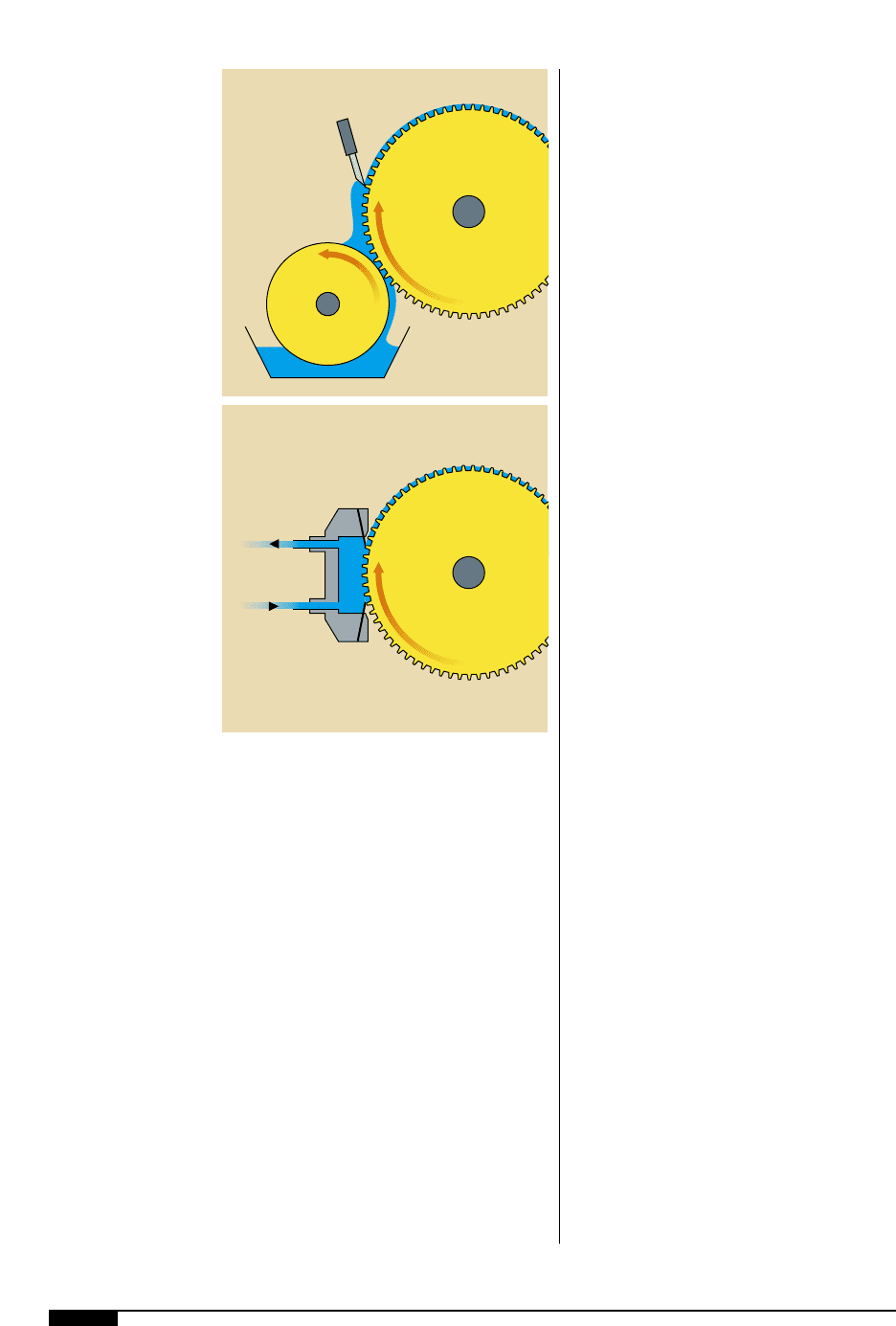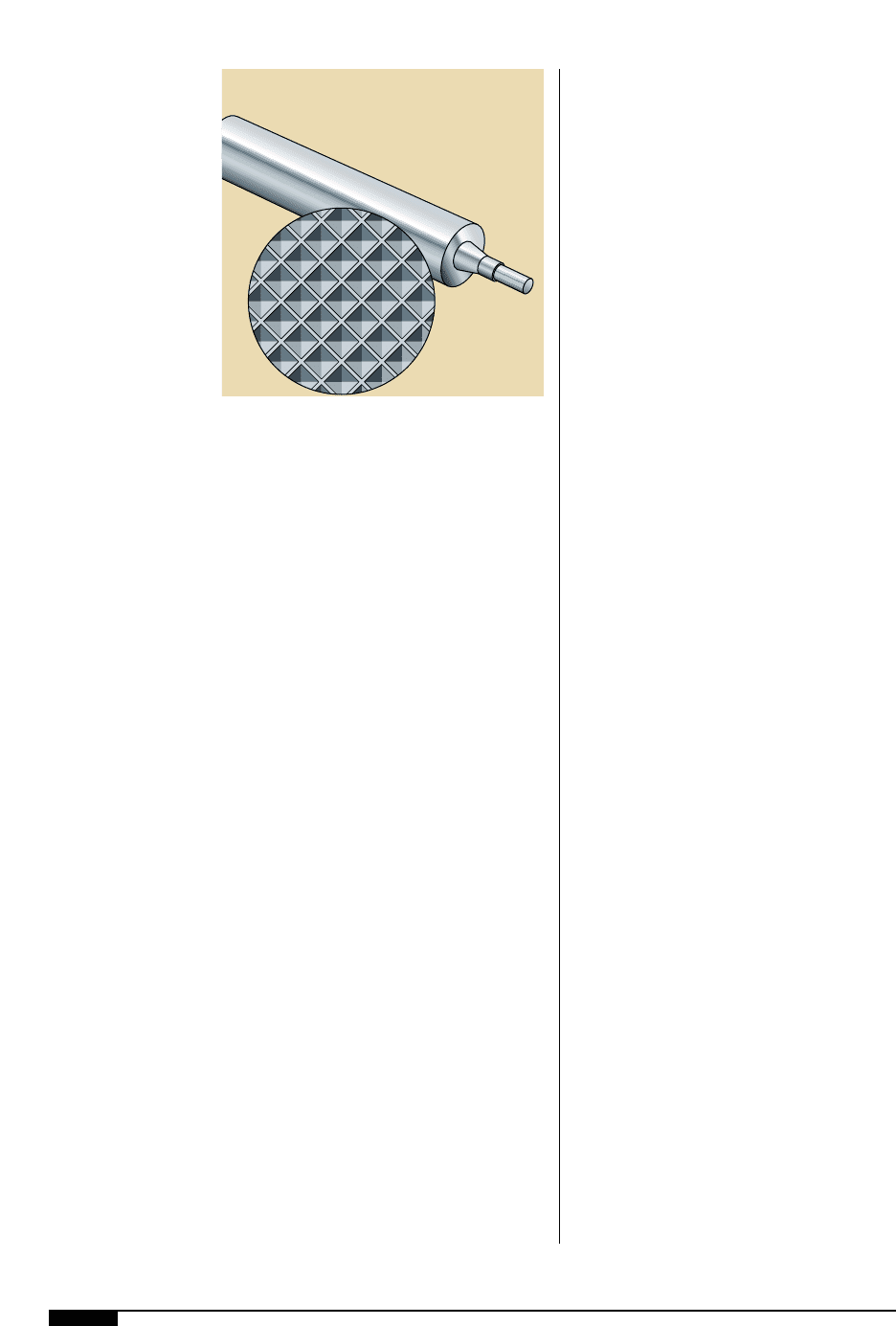FTA (изд-во). Flexography: Principles And Practices. Vol.1-6
Подождите немного. Документ загружается.


72 FLEXOGRAPHY: PRINCIPLES & PRACTICES
The pressure setting of the reverse-angle
doctor blade should be maintained at a min-
imum level consistent with the uniform
transfer of a thin ink film. Tests were con-
ducted many years ago by press manufac-
turers, ink makers, anilox roll manufacturers
and others which concluded that the correct
pressure setting of a reverse angle doctor
blade should not exceed quarter-ounce of
pressure per inch. The tests showed that
when the pressure was increased to half
ounce per inch, a noticeable amount of wear
to the anilox cells was detected.
A variety of doctor blade materials have
entered the industry over the years, ranging
from high tensile, tempered blue steel; to
plastic, some of which is reinforced with
synthetic fibers. Many of these changes
came about because of the conversion from
solvent-based to water-soluble ink systems.
Each flexographic printer should determine
the type of doctor blade material which per-
forms best for the particular operation.
Some plants have found that a stainless-steel
doctor blade works best, while other plants
use non-reinforced plastic materials. Re-
gardless of the material used for the doctor
blade itself, the primary concern must be on
the pressure setting. Keep in mind that
excessive pressure can only create friction,
which in turn will create excessive wear.
Chambered Doctor Blade
The chambered doctor-blade system is the
newest system used by the flexographic
printing industry. The chamber blade unit is
comprised of two doctor blades, one of
which is a reverse-angle doctor blade that
does the job of actually doctoring the ink
from the anilox roll, and the other is a con-
tainment blade that holds the ink in the
chamber. The two blades are preset at spe-
cific angles for proper doctoring and are
affixed to a backing plate that forms the
three-sided unit (Figure
6(
). When this unit
is applied to the anilox roll, a chamber is
formed between the anilox roll and the
three-sided fixture. The sides of the anilox
roll are sealed with pads of felt, rubber or
plastic material. These side-sealing mecha-
nisms may be spring-loaded or pressure-
loaded. When ink is pumped into the cham-
ber, it becomes somewhat pressurized.
Chambered doctor-blade systems help
reduced the solvent or water evaporation
from the ink, keeping the ink flow character-
istics under control. A critical element in the
operation of the chambered doctor-blade sys-
tem is that the pressure settings must be
maintained as recommended by the original
equipment manufacturer. Some of these units
have air-loaded pressure controls, while oth-
ers offer manual controls and include a set
screw installed as a protective stop to prevent
6*
A reverse-angle doctor-
blade system allows a
precise ink-film thick-
ness to be transferred
to the printing plate at
various operating
speeds without press-
side adjustments.
6(
Chambered doctor-
blades are the newest
systems in fleoxogra-
phy. Comprised of two
doctor blades, a
reverse-angle blade to
doctor the ink from the
anilox roll; and a con-
tainment blade, to hold
the ink in the chamber.
Anilox
Roll
Doctor Blade
Metering
Roll
6*
Anilox
Roll
Ink Out
Ink In
6(

excessive pressure. Do not attempt to read-
just these stops. Excessive pressure settings
can destroy an anilox roll in a very short peri-
od of time.
Safety Concerns. When handling doctor
blades, either to clean them or install them,
all safety precautions should be taken.
Regardless of the material, doctor blades are
sharp and can cause serious injury if not han-
dled with care. Steel blades are generally in
the 0.004" to 0.009" thickness range and
should be considered to be as sharp as a razor
blade. Handle them with care and caution.
THE ANILOX ROLL
With the improvement of quality standards
for inks, printing plates and presses, flexog-
raphy is now able to perform process print-
ing which was not possible in the past. One
of the many reasons for this improvement
has been the ability to maintain a specific
volume of ink transfer over a long period of
time. The primary function of the anilox roll
is to meter and control the flow of ink from
the reservoir to the printing plate. With the
development of laser engraving and ceramic
coatings for anilox rolls, the longevity prob-
lem has been answered. To obtain maximum
productivity from the anilox roll, it is impor-
tant to understand how they are produced.
The anilox roll is a cylinder that has been
engraved with a uniform pattern of cells
around and across the entire surface. Cells
may be mechanically engraved with an
engraving tool, chemically etched or
engraved through the use of a laser beam.
Regardless of the method of engraving, each
cell must be uniform and identical in both
size and depth to ensure that a controlled,
uniform ink-film thickness is transferred to
the printing plate.
Anilox Nomenclature
The engraving on an anilox roll has been
given many names, among them are cells,
lines or screens. These names refer to the
actual cells that are engraved on the roller.
Anilox cells that are mechanically engraved
are set at a 45° angle to the roll axis and
anilox cells are counted along that angle.
Laser engraved anilox rolls can be produced
at any given angle, but the industry has set-
tled on the 60° engraving angle after detailed
testing for ink receptivity and ink transfer
characteristics. Testing revealed that the 60°
angle worked best for flexographic printing.
Other angles of engraving are used for spe-
cific purposes or industries, such as the 45°
angle which has been the standard for flexo
printing of newspapers, or the 30° angle
which seems to be widely accepted for
industrial coating applications (Figure
7)
).
The nomenclature of an anilox roll relates
to the number of cells in one linear inch
along the engraving angle. For example a
165 anilox roll would contain 165 cells in a
linear inch. Occasionally, this cell count may
differ slightly and is rounded out to the clos-
est number. A nominal 200-line anilox roll
for example, may actually contain 203 or 204
cells in a linear inch.
Mechanical Engraving
The anilox roll was originally engraved
mechanically by using an engraving tool.
The engraving tool was forced into the sur-
INK 73
7)
The different anilox
engraving angles.
60° angle works best
for flexographic printing.
45° angle is used for
flexo printing of news-
paper. 30° angle is used
for industrial coating
applications.
30°
45°
60°
7)

74 FLEXOGRAPHY: PRINCIPLES & PRACTICES
face of a steel- or copper-plated cylinder
with sufficient pressure to emboss the sur-
face metal of the cylinder into the cavities
formed by the teeth of the engraving tool.
The result is a reverse pattern of the tool on
the surface of the anilox roll (Figure
7!
).
Each tooth on the tool begins with a single
punch designed to hold a specific volume of
ink. From the single punch, an engraving tool
is made with every tooth measured for accu-
racy. Thus, when the tool is used to make an
anilox roll, each cell formed is identical.
When the cells have been formed in the
base metal of the anilox roll, the next step is
to protect the surface of the cells from cor-
rosion and wear. This is accomplished by
electroplating nickel over the engraving to
provide corrosion resistance and then apply-
ing a layer of double-hard chrome plating to
provide durability. While chrome plating pro-
vides excellent ink receptivity and release, it
cannot withstand the pressures of doctor-
blade metering and wears rapidly. Attempts
have been made and continue to be made, to
extend the life of anilox rolls by electroplat-
ing specialized coatings to provide durability,
but most have been unsuccessful.
Ceramic-coated Anilox Rolls
Because chrome-plated anilox rolls did not
have the durability to withstand the pressure
settings of a doctor-blade system, ceramic
coating was developed. Ceramic coatings are
applied through a plasma-coating system in
which ceramic particles are melted at very
high temperatures and forced onto the sur-
face of a cylinder by using a gas-fired propel-
lant. The ceramic coating provides an
extremely durable and very hard surface
which resists wear and impact that would
normally damage a chrome-plated roller. The
result is the mechanically engraved, ceramic-
coated anilox roll, in which a ceramic coating
is applied to an engraved surface in place of
the chrome plating.
A major problem with ceramic coating
over an engraving is that the coating is limit-
ed to medium-range anilox cell counts of 200
or 220. Attempts to ceramic-coat finer anilox
cell counts found that cell integrity was lost
because the cells would become filled with
ceramic material. In order to preserve cell
definition, most anilox roll suppliers limited
the ceramic coating to a maximum engrav-
ing of 200 or 220. Most manufacturers limit
the amount of ceramic coating over an
engraving to 0.001" for fine screens and
0.003" for coarser engravings.
Laser Engraving
Since ceramic coating of fine line-engraved
anilox rolls was not practical, a new method
of engraving was required. Furthermore,
with the development of the chambered doc-
tor-blade system a more durable surfaced
anilox roll was a necessity. Through much
research and development, the laser-
engraved ceramic anilox roll was invented
and has become an integral part of the flexo-
graphic printing industry. A laser-engraved
roller begins with a cylinder which is plasma
coated with a thick layer of chromium oxide
ceramic material. Chromium oxide material
was selected for the coating because ink
release and ink receptivity characteristics
are comparable to chrome plating. This coat-
ing material has an extremely hard surface
7!
Enlarged detail of a
mechanically-engraved
anilox roll showing the
reverse pattern made
from the engraving tool
used to emboss the
surface of the roll.
7!

which resists impact and abrasion, providing
a very durable roll surface.
The ceramic coating is ground and pol-
ished with a diamond wheel to a super-
smooth finish and then a laser beam is used
to burn a cell directly into the ceramic mate-
rial. Laser engraving equipment is computer-
controlled and is capable of engraving very
fine anilox cells. Cell counts of 1,000
upwards to 1,500 or more per linear inch are
now possible with the use of a laser-engrav-
ing machine. Laser engraving offers much
more flexibility and the same cell count can
be made in different cell depths and vol-
umes. The 60° angle of the laser-engraved
cell forms a hexagonal “nested” cell struc-
ture offering better ink release and cell effi-
ciency than the 45° angled cells.
Volumetric Carrying Capacity
Since all of the cells on an anilox roll are
identical in size, the volumetric carrying
capacity can be determined by the actual
measurement of a single cell using a mathe-
matical formula. Volumetric carrying capaci-
ty is the amount of ink contained in the total
number of cells within a square inch.
Because of the development and improve-
ment of anilox rolls over the years, there
have been many changes in the equipment
used to measure and calculate volume. For
chrome-plated mechanical engravings, opti-
cal measuring instruments are generally
used. A microscope is used to measure the
depth of the cell, the cell opening at the top
and the width of the bottom of the cell
(Figure
7@
). These measurements are read in
microns (25,400 microns to an inch). When
the measurements have been made and the
cell count established, the following formula
is used to calculate the specific volume in bil-
lion cubic microns per square inch.
SPECIFIC VOLUME CV C2
CV D/3 O2 B2 O B
Where:
CV = volume of single cell
C = cell count (165, 200 etc.)
D = depth of cell
A
1
= cell top area
A
2
= cell bottom area
Knowing the specific volume or volumet-
ric carrying capacity of the anilox roll allows
the flexo printer to determine if the anilox
roll is carrying the precise amount of ink
needed to properly ink the printing plate. A
loss in volume may be attributed to either
wear of the cell or to plugging of the cell
because of improper or infrequent cleaning.
Liquid Volume Calculations. When a micro-
scope is used to measure an anilox cell, the
measurements are determined by the light
that is reflected back into the lens. Since
ceramic material absorbs light, there is little
reflection and an accurate measurement of
the cell is extremely difficult.
A liquid volume method was developed
based upon the principle that a known vol-
ume of fluid will spread only as far as the
surface roughness or cell structure on the
roller allows it to be spread. A known quan-
tity of ink ( usually 25 microliters) is applied
to the surface of the anilox roll using a pre-
cise pipette or syringe. The ink is then
spread around the circumference with a
hand-held doctor blade. A sheet of white
INK 75
7@
Volumetric carrying
capacity is the amount
of ink contained in the
total number of cells
within a square inch.
Measurements of cell
depth, cell opening at
the top and the cell
width at the bottom of
the cell are then
plugged into the
specific volume
formula.
A
2
Bottom Area
A
1
Cell Top Area
D
Cell
Depth
Wall
Width
7@

76 FLEXOGRAPHY: PRINCIPLES & PRACTICES
bond paper is placed over the ink smear and
a footprint of the area covered with ink is
made. The area is measured and a calcula-
tion is made to determine the volumetric
carrying capacity.
While this method is very accurate, it is
dependent upon the ability of the individual
to uniformly apply the bead of ink, spread the
ink, take the footprint and finally measure the
outline. There will be differences in the cal-
culated volume among individuals doing the
volume check because of the level of experi-
ence in performing that task. As a result, the
liquid-volume measurement should be taken
from three different areas on the anilox roll
and the volumes averaged. The average
should be used as a starting point to deter-
mine wear and durability of the anilox roll.
An improvement on the method just ex-
plained incorporates the use of a surface-
treated clear-polyester sheet, like those used
in inkjet printers, and a wide hand-held tack
roller, like the ones used to remove dust
from negative films. The ink-jet film is rolled
around the tack roller with the treated sur-
face outside. The covered roller is pressed
against the surface of the anilox and the ink
from the microliter-syringe is introduced
into the nip (Figure
7#
). The ink-jet film is
rolled against the anilox, spreading and
printing the ink volume simultaneously. This
method removes most of the operator error.
Comparative volumes of new and partially
worn or plugged rolls may be checked by
simply weighing the cut silhouette of the ink
patches.
Vertical Scanning Interferometry. A more sci-
entific approach to accurately measure vol-
ume involves using an interferometric scan-
ning device. This device was designed by
incorporating the technology used in manu-
facturing fiber-optic equipment and comput-
er discs. It is also used in several aerospace
programs by the United States government.
The interferometric measuring method has
been adopted by the leading manufacturers
of anilox rolls as the most accurate measur-
ing device currently developed. The cost of
these more scientific measurement instru-
ments may be too high for the average flexo-
graphic printer to consider. As a result, many
printers correlate the readings by the anilox
roll manufacturer with actual liquid volume
measurement taken by their inspection per-
sonnel. Charts using both volume measuring
systems can be logged by the printer to
determine the durability of anilox rolls, thus
enabling timely roll changes before a critical
print job is to be scheduled.
The interferometric device uses a three-
dimensional scanning head positioned on an
anilox roll while connected to a computer
and a TV monitor. The device scans all of the
cells in the viewing eyepiece at a rate of
some 5,000 readings per second. Light waves
are bounced against each of the interior
anilox cell walls from the top to the bottom
of each cell and the distance is recorded.
This information goes into the computer,
which has been programmed with the prop-
er algorithm. The computer then calculates
the volumes of each of the cells in the view-
ing area and averages them to determine the
volume for that particular anilox roll. Tests
by the United States Bureau of Standards
have found this interferometric method to
be accurate to within 0.03%.
7#
Liquid-volume
measurement requires
the ink-jet film to be
rolled around the tack
roller with the treated
surface outside. The
covered roller is then
pressed against the
surface of the anilox and
ink from the micro-liter
syringe is introduced
into the nip. The ink-jet
film is rolled against the
anilox, spreading and
printing the ink volume
simultaneously.
Hand
Roller
Microliter
Syringe
Inkjet Film
Anilox Roll
Printed Area
Microliters used
Area ( sq.in.)
= Volume (bcm)
7#

Anilox Selection
Selecting the best anilox roll for the type of
flexographic printing produced can be some-
what perplexing, but knowing a few details
can make this decision much easier. First of
all, there are flexo printers in many different
industries and each one prints on a wide
variety of substrates. Wide-web printers print
on film, paper or foil. Narrow-web printers
use absorbent or chrome-coated glossy
stock. Corrugated printers print on a multi-
tude of surfaces from bleached high-holdout
to highly absorbent kraft linerboard. Each of
these substrates has individual characteris-
tics relating to ink absorbency and drying
that the printer should be aware of. The same
anilox roll cell-count and volume cannot be
used to print the same image on each of
these diverse substrates. As a result, this
textbook cannot provide an accurate deter-
mination of which cell count and volume will
work best for each of these industries.
Wide-web film printers may use a 220-line
anilox roll with a volumetric carrying capac-
ity of 7.7BCM/in
2
to print a large solid, while
a corrugated box printer may use a 180-line
anilox roll with a volume of 9.5 BCM/in
2
in
order to print the same image on kraft liner-
board. With these different substrates and
image requirements, the flexo printer should
consult his anilox roll supplier to customize
the anilox roll and volume to best suit each
specific need.
Table 10 can be used as a guideline for the
selection of anilox cell counts and volumes
for coarse screen rulings. Again, each print-
er must assess which anilox roll performs
best for his own need.
Note: Cell counts and volumes in Table 10
are based upon standard print require-
ments and printing plates for halftone
screens with fewer than 85-lines per inch.
Results are dependent upon a number of
variables including the condition and the
type of printing press, the speed of printing,
the skill of press operator and the surface
finish of the substrate. For advanced and
high graphics requirements, both ink- and
anilox-roll suppliers must be consulted and
work together.
The flexo printing ideology is to print with
the thinnest ink film possible, while main-
taining color density, and to run the press as
fast as possible. This is accomplished only
through the use of high-strength inks that
quickly dry and a fine anilox roll with a small
volumetric carrying capacity. With this in
mind, there are several guidelines to consid-
er when purchasing anilox rolls.
First of all, the printer must assess the con-
dition of the printing press and the experi-
ence of the press crew, so that he/she is
assured the desired image requirements can
be achieved. The press crew must be capable
of operating the press to attain that objective.
In addition, the press crew has to have been
thoroughly trained in the mechanics of the
press. The press must have been fingerprint-
ed to determine press characteristics such
as, pressure settings, registration and dot
INK 77
Table 10
SUBSTRATE ABSORBENT (PAPER) NONABSORBENT (FILM)
IMAGE CELL COUNT VOLUME (BCM) CELL COUNT VOLUME (BCM)
Solids 180 9.5 220 7.5
Line 200 8.3 250 7.0
Halftone 250 7.0 360 4.5
ANILOX SELECTION GUIDE

78 FLEXOGRAPHY: PRINCIPLES & PRACTICES
gain. Once all of these conditions have been
met, the anilox selection process can begin.
After the image requirements have been
determined, the printer can begin to develop
specifications for the anilox roll. If the image
is pictorial and process printing is a require-
ment, then several considerations must be
taken into account. One is that the line
screen of the printing plate must be known,
so that the anilox roll cell count is fine
enough to correctly ink each of the halftone
or process screen dots.
While there are several schools of thought
concerning the ratio of anilox cell count to
halftone or process dots, the prevailing one is
to have the anilox roll four times or more than
that of the halftone line screen. For example,
if the printing is a 110-line screen plate, then
the anilox roll must be 440 or finer in order to
ink each of the dots without having a single
dot dunk into an anilox roll cell. Dot dunking
can be a concern, especially where a printing
plate has very fine highlight dots of 1% , 2% or
even 3%. Should the printing plate contain
highlight dots of 3% or less, then the printer
should consider using an anilox roll with a
higher screen count, i.e., five or even six times
the halftone screen count.
Tables 11 and 12 provide dimensional
information on halftone dot and anilox cell
dimensions. The tables are based on a cell
wall thickness of 5 microns. Table 11 shows
the size, in microns, of 1%, 2% and 3% dots at
various screen rulings. Next, the size of the
dot is the cell count, where the opening of
the anilox cell just equals the size of the dot.
For example, at 120 lpi, a 2 % dot has a diam-
eter of 34 microns. This corresponds to an
anilox-cell count of 654. Hence, a 660 anilox
roll would have a cell size smaller than the 2%
dot. Table 11 shows the cell opening for
some common anilox-cell counts. The tables
can be used to help determine which anilox
roll to use.
Optimum Volumes. Volumetric carrying
capacity is an important consideration when
selecting anilox rolls with screen counts of
440 or higher. With all anilox rolls, the rec-
ommended volumetric carrying capacity
should be determined by the depth-to-open-
ing ratio in order to obtain clean ink recep-
tivity and ink release from the anilox cells. It
is suggested that anilox rolls should have a
depth-to-opening ratio between 23% to 33%,
in order to allow the ink to smoothly enter
and release from the anilox cells. Higher
ratios, where the cells are deeper, may have
a tendency to plug with dried ink after a peri-
od of use. The deeper cell does not evacuate
a sufficient amount of ink to allow total res-
olubility of the remaining ink in the cell when
mixed with fresh new ink. Thus, the ink will
Table 11
SCREEN ANILOX CELL ANILOX CELL ANILOX CELL
RULING 1% DOT COUNT 2% DOT COUNT 3% DOT COUNT
(LPI) (MICRONS) (PER IN) (MICRONS) (PER IN) (MICRONS) (PER IN)
85 34 655 48 481 58 400
100 29 754 41 557 50 464
110 26 817 37 606 45 506
120 24 878 34 654 41 547
133 22 956 31 715 37 599
150 19 1052 27 792 33 666
175 16 1187 23 901 28 760
200 14 1313 20 1004 25 851
DOT SIZE EQUAL TO ANILOX CELL OPENING

dry more rapidly and plug the anilox cell.
Shallower cells are very difficult to produce
and duplication of the cell volume may not be
maintained when re-engraving. Shallower
cells also have distorted cell walls separating
each cell and may not allow smooth entrance
and exit of the ink.
Anilox cell counts and volumes for
process printing can range from a low of 220
lines with a volume of 7.7 BCM to a high of
900 lines with a volume of 1.5 BCM. The
finer the cell count, the smaller the cell size
and smaller volume.
Appendix A lists some recommendations
for cell count and volume.
Banded Anilox Rolls. In order to correctly
determine which anilox roll works best, the
flexo printer should purchase a banded
anilox roll from his supplier. This roll should
be engraved with bands of different anilox
cell counts and volumes. These bands can be
as small as a few inches or as large as a foot
or more. Test plates can be made to order for
a specific industry and some plate makers
may have stock test plates available which
will contain useful information. The use of
banded anilox rolls should provide useful
information to the printer so that specifica-
tions can be determined for the anilox roll
cell count and volume that works best on the
press for particular print jobs. Every flexo
printer should know the capability of their
printing press and a test using a banded
anilox roll should enable that printer to
develop a storehouse of data to assist in pro-
viding better quality printing to the clients.
Anilox Maintenance
As printing has become more demanding,
anilox cells have become smaller and shal-
lower, the drying time of inks has decreased.
Add to this the requirements brought about
by new ink-metering systems, and it is clear
that the ink industry has improved ink quali-
ty. Better dispersions are necessary to obtain
desired strength and clean print from the
shallow ds. If the incorrect ink formula is
used, it is possible for large pigment particles
to plug anilox cells.
Regardless of the type of anilox roll used,
whether it is a fine-screen laser engraving or
a very coarse chrome-plated roll, it still must
be cleaned as often as possible. Considering
that water-borne ink systems are used in the
majority of flexo printing operations and the
characteristics of this ink are similar to latex
paint, it is easy to see that cleaning is a criti-
cal part of extending the life of anilox
rollers. The anilox roll should be scrubbed
with the correct brush and an approved
cleaning solution. Brass-bristle brushes
should only be used for chrome-plated
anilox rolls, while fine-bristle stainless-steel
brush should be used for cleaning laser-
engraved ceramic-coated rollers. Caution
must be exercised in the selection of a clean-
ing solution. Flexo printers should consult
with both their ink supplier and their anilox
roll supplier for an approved flexo cleaning
solution. The use of a high pH or caustic
cleaning solution can void any warranty
expressed by the roll supplier.
Anilox rolls should be cleaned as often as
INK 79
Table 12
ANILOX COUNT CELL OPENING
(CELLS PER INCH) (MICRONS)
250 97
300 80
360 66
400 59
440 53
500 46
600 37
660 33
700 31
800 27
1,000 20
1,200 16
ANILOX CELL OPENING

80 FLEXOGRAPHY: PRINCIPLES & PRACTICES
possible, but in every instance no fewer than
once a day, or once every shift. A cleaning
program should be employed to thoroughly
clean and brush anilox rolls whenever the
printing station is to be idled. Should the
anilox roll become clogged with dried ink,
then an aggressive cleaning method must be
employed, such as pressure washing or
ultrasonic cleaning.
Anilox rolls must be cleaned while the ink
is still wet and fluid. This will reduce the
clean-up time and make the job of cleaning
much easier. Dried ink is difficult to remove
from the bottom of the anilox cell and cured
ink may not come off at all. A maintenance
program should be developed and discussed
with the anilox roll supplier in order to pro-
vide maximum productivity and maximum
longevity of the rollers. Many roll suppliers
even sell a recommended cleaning solution.
Should pressure washing of anilox rolls be
an accepted procedure, then it is suggested
that a complete training program be devel-
oped. Some pressure washers have an auto-
matic traversing wand and vacuum system
where the cleaning media, such as bicarbon-
ate of soda, is blasted onto the anilox roll sur-
face and removed instantaneously. These sys-
tems are regulated as to traversing speed and
pressure settings. Other systems have a man-
ual wand unit and the manufacturers of these
manual-controlled units recommend that the
wand be traversed across the roller at a rate
of 12 in/sec. Slower movement may cause
irreversible damage to the anilox roll surface.
Additionally, there are ultrasonic cleaning
units, soak tanks and other cleaning systems
available to the flexo printer. Ultrasonic
cleaning systems are excellent for cleaning
high line anilox rolls, but recently there has
been evidence that they may cause damage
to the cell structure. Therefore, ultrasonic
cleaning should be used with caution.
Since cleaning of the anilox roll is pivotal
to the longevity of the roll, the use of any
cleaning procedure or system should be
thoroughly discussed and approved by your
roll supplier. Regardless of the type of
anilox, ink cannot be allowed to dry in the
cells. Ink flow over rollers must be main-
tained when the press is stopped, or the rolls
must be cleaned immediately. The specific
cleaning material should be that recom-
mended by the ink supplier.
In the clean-up phase, solvent-based inks
are more forgiving than water-based sys-
tems. Solvent-based inks not only can wait
longer before being cleaned, but the inks
also resolubilize in a wider range of solvents
with less elbow grease. Water-based inks
must be cleaned immediately. A combina-
tion such as this one can be used:
10%–20% Mild Alkali (no ammonia)
60%–70% Water
20% Solvent (propyl alcohol or
a propyl ether derivative)
Excessive alkali and/or amines can cause
pitting in chromed cylinders and so should
not be used. Make sure to rinse well after
cleaning, or it can cause problems in the
next inks used with that cylinder. This is true
for water- and solvent-based inks.
Many inks are not compatible with each
other, so when changing from one ink to
another for a different job, be sure to clean
very thoroughly. This practice will avoid
potential for the inks to kick out in the cell
and cause multiple problems.
INK PUMPS
While there are many different types of
pumps available today, those in wide use are
the peristaltic and the centrifugal pumps.
Peristaltic pumps are used primarily on
short runs, as they are easy to clean and
change over. They do require somewhat
more maintenance, however, and inks do
not circulate well with this pump.
The centrifugal pump is the most widely
used today. It works well on long runs and
requires little maintenance. The pump action

keeps the ink circulating. Regardless of the
type of ink pump used, some common guide-
lines should be followed:
• the pump should be designed with
materials that are compatible with ink
components;
• if water-based inks are being used, it is
important that the pumps be corrosion
resistant; and
• if solvent-based inks are used, the
pumps should have components that
are resistant to the various ink solvents.
Ink-return hoses should be submerged into
the ink sump as low as possible, that is,
always below the ink surface. This reduces
the production of foam in the ink pump.
Although critical for water-based inks, it is
also beneficial for solvent-based inks. The
pump must deliver the required flow of ink
over a wide range of viscosities, fountain
heights and coverage rate, and it is recom-
mended that the pump be as universal as pos-
sible. It must be relatively easy to clean the
pump, and there should not be any internal
surfaces that can hold dry ink. The inking sys-
tem should self-drain when the pump is shut
off, otherwise, ink waste increases and the
required cleaning becomes more difficult.
Flexo ink tends to “layer” if allowed to sit in
a container. Also, solvent additives need to be
mixed thoroughly and quickly, before they are
circulated to the print deck. If using piston,
screw, peristaltic or diaphragm pumps, addi-
tional tank agitation, usually a smaller mixer,
is probably needed. The pump intake should
reach almost to the bottom of the ink reser-
voir to pick up heavier materials and facilitate
maximum pump-out at the end of a run.
When using any type of doctor blade, uni-
form and constant pressure must be main-
tained across its full length. Pulsating pumps
(piston, diaphragm) can cause higher pres-
sure against the doctor blade, lifting it off the
cylinder.
Ink Sump Design
A properly designed ink sump should con-
tain a minimum amount of ink. This will
reduce the amount of press-return ink that
would have to be reworked into a new print
job. In addition, by maintaining a minimum
amount of ink in the sump, the solvent bal-
ance of the ink is better controlled.
An ink sump should also have good circu-
lation through the entire print deck, with no
dead spots in the ink pan. This will reduce
any tendency for the ink to settle in the pan.
This is especially important when using
heavy gravity colorants, such as white or
metallic, and also with fluorescent inks that
are not highly dispersed.
The ink sump should be covered to avoid
loss of solvents during the pressrun. This will
not only save money by reducing the amount
of make-up solvent needed, but it will also
maintain a more constant solvent balance in
the ink, resulting in cleaner printing.
Press-Side Ink Filtration
When inks are manufactured, they are fil-
tered while being filled into their shipping
containers. After the inks are put into the
sump, they can become contaminated by a
variety of factors. If printing on paper, there
can be a major contamination with paper
fibers.
Regardless of what substrate is printed,
contamination is always possible. To remove
this contamination, use in-line press filters.
This prevents dirty printing and/or clogged
anilox rollers. Any ink that has been previ-
ously used in a press and is being reused
must be filtered before being returned to the
press. Clean ink is absolutely necessary to
high print quality. With the current bladed
presses, dirt may get trapped under the
blade and cause anilox damage.
PRESS SETTINGS
Keeping a log of all the jobs that are run is
INK 81
